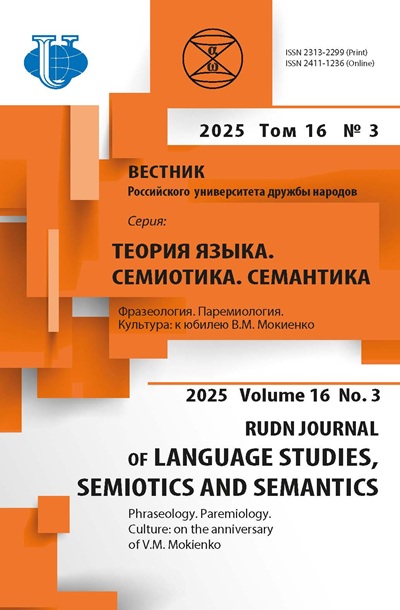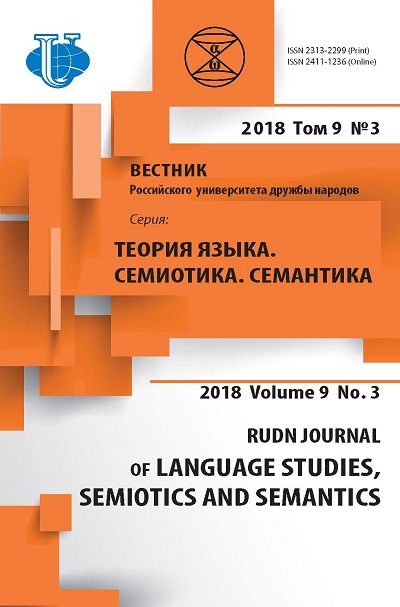ПОЧТИТЕЛЬНЫЕ ОБРАЩЕНИЯ В БРИТАНСКОМ ВАРИАНТЕ АНГЛИЙСКОГО ЯЗЫКА И АМЕРИКАНСКОМ ВАРИАНТЕ АНГЛИЙСКОГО ЯЗЫКA
- Авторы: Юрьева ЮБ1
-
Учреждения:
- Российский университет дружбы народов
- Выпуск: Том 9, № 3 (2018)
- Страницы: 685-695
- Раздел: НАУКА 21.0
- URL: https://journals.rudn.ru/semiotics-semantics/article/view/19433
- DOI: https://doi.org/10.22363/2313-2299-2018-9-3-685-695
- ID: 19433
Цитировать
Полный текст
Аннотация
Цивилизация на современном этапе развивается по пути расширения сотрудничества стран в экономической, политической, социальной и культурной сферах, углубления глобализационных процессов. Результатом этого взаимодействия является быстрый темп роста количества культурных обменов и прямых контактов между государственными учреждениями, социальными группами и отдельными лицами разных стран и культур. Взаимосвязь языка и культуры играет важную роль в общении как между членами одной группы, так и с представителями других культур. Английский - это глобальный язык; термин «английский как международный язык» (EIL) включает в себя британский вариант английского языка (BrE), американский вариант английского языка (AmE), канадский вариант английского языка (CanE) и австралийский вариант английского языка (AusE). Данное исследование рассматривает различия в использовании почтительных обращений в двух вариантах английского языка - в британском и американском - в адресных формах, используемых в повседневном взаимодействии, а также предлагает объяснения различий в их употреблении, вызванных социальными и межличностными отношениями, культурными ценностями и стратегиями вежливости. Недавнее исследование адресных форм имеет актуальное значение, поскольку оно помогает нам описать культурные особенности говорящего и определить различия в использовании почтительных обращений в AmE и BrE. Мы используем классификации Г. Хофстеда (1991), постулаты теории вежливости (Brown and Levinson 1987, Hickey and Stewart 2005, Leech 2014), Основные положениея межкультурной прагматики (Kecskes 2014, Wierzbicka 1991/2003). Исследование было проведено на языковом материале, полученном с помощью наблюдений, анкетирования и интервью, в которых содержится ряд вопросов и ситуаций, охватывающих различные социальные контексты: ежедневное общение с собеседниками разного возраста, пола и рода занятий. Основное внимание в исследовании уделяется тенденциям, которые иллюстрируют влияние культуры на использование почтительных обращений в британском варианте английского языка и американском варианте английского языка.
Об авторах
Ю Б Юрьева
Российский университет дружбы народов
Автор, ответственный за переписку.
Email: yureveyb@gmail.com
аспирант кафедры иностранных языков филологического факультета РУДН; научные интересы: сравнительно-сопоставительное языкознание, прагматика, дискурсивный анализ, методика преподавания иностранных языков
117198, Москва, ул. Миклухо-Маклая, 10/2, РоссияСписок литературы
- Larina T. Culture-Specific Communicative Styles as a Framework for Interpreting Linguistic and Cultural Idiosyncrasies. International Review of Pragmatics, Vol. 7, no 5. Special Issue: Communicative Styles and Genres, 2015, pp.195—215.
- Hofstede G.H. Cultures and Organizations: Software of the mind. McGraw-Hill Book Company (UK) Limited. London, 1991.
- Brown P., Levinson S. Politeness: Some Universals in Language Usage, Cambridge: Cambridge University Press, 1987.
- Hickey L. and Stewart M. Politeness in Europe. England: Multilingual Matters. 2005.
- Leech G. The pragmatics of politeness. Oxford: Oxford University Press, 2014.
- Kecskes I. Intercultural Pragmatics. OUP USA, 2014.
- Wierzbicka A. Semantics, Culture, and Cognition: Universal Human Concepts in Culture-Specific Configurations. New York: Oxford University Press, 1992.
- Clyne M., Norrby C., Warren J. Language and Human Relations: Style of Address in Contemporary Language. Cambridge: CUP, 2009.
- Hofstede G.H. Culture’s Consequences: International Differences in Work-Related Values. Beverly Hills CA: Sage Publications, 1984.
- Fitch K. Speaking Relationally: Culture, Communication, and Interpersonal Connection. New York: The Guilford Press, 1998.
- Zhang X.A. Comparative Study of the Sino-American Address Forms from an Intercultural Communication Perspective. International Journal of English Linguistics. (1): 54—60, 2011.
- Larina T. Too many walls and not enough bridges: The importance of intercultural communication studies. Russian Journal of Linguistics, Vestnik RUDN, (4): 9—16, 2015.
- Денисова В.Л. Языковая ситуация в китайской диаспоре Австралии на основе данных социолингвистического эксперимента. Филология. Искусствоведение. Вып. 65. С. 41— 43. 2012.
- Швейцер А.Д. Социальная дифференциация английского языка в США. М.: Наука, 1983.
- Авронин В.А. Проблемы изучения функциональной стороны языка. Л.: Наука, 1975.
- Жеребило Т.В. Языковое состояние в условиях билингвизма (на примере Чеченской Республики). 2-е изд., испр. и доп. Назрань: Кеп, 2016.
- Kachru B. World Englishes: Agony and Ecstasy // Journal of Aesthetic Education Vol. 30, no 2, 2012. Special Issue: Distinguished Humanities. C. 135—155.
- Ощепкова В.В. Язык и культура Великобритании, США, Канады, Австралии, Новой Зеландии. М.; СПб.: ГЛОССА/КАРО, 2004.
- Clyne M. Address in intercultural communication across languages // Intercultural Pragmatics. no 6(3), 2009. C. 395—409.
- Ларина Т.В. Категория вежливости и стиль коммуникации: сопоставление английских и русских лингвокультурных традиций. М.: Языки славянских культур, 2009.
- Ларина Т.В. Английский стиль фатической коммуникации // Жанры речи. Саратов: Колледж, 2005. Вып. 4. С. 251—262.
- Larina T., Suryanarayan N. Madam or aunty ji: address forms in British and Indian English as a reflection of culture and cognition. In Monika Reif, Justina A. Robinson, Martin Putz (eds.) Variation in Language and Language Use: Linguistic, Socio-Cultural and Cognitive Perspectives Series, Peter Lang, pp. 190—217, 2013.
- Илиади П.Л., Ларина Т.В. Стратегии отказа в английской и русской лингвокультурах // Вестник Российского университета дружбы народов Серия: Теория языка. Семиотика. Семантика, 2017. T. 8. no 3. C. 531—542. doi: 10.22363/2313-2299-2017-8-3-531-542.
Дополнительные файлы












